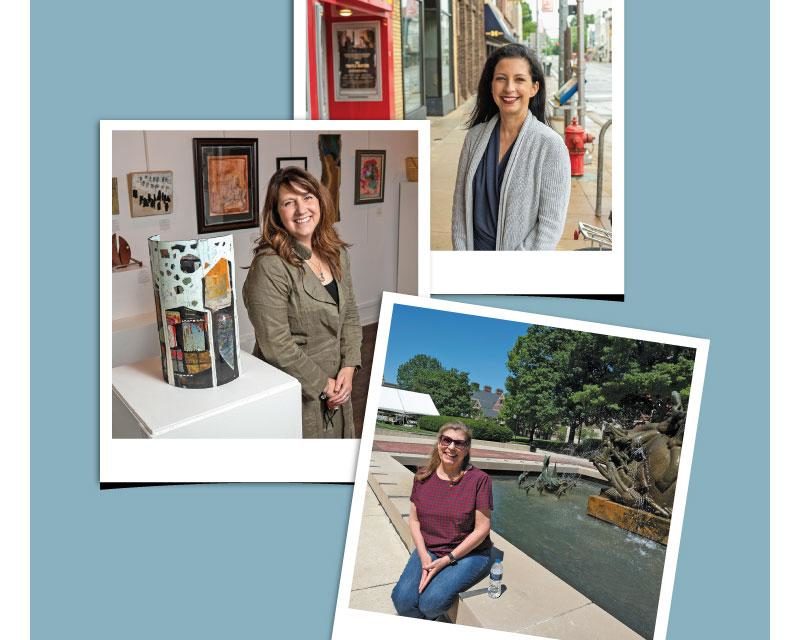Update: The map in the July 2021 Observer missed two important changes: there is no Art-Go-Round this year, and the Briarwood park-and-ride shuttle is operated by Trinity Transportation rather than TheRide. See the official fair map here
In mid-May, with Michigan still limiting outdoor gatherings, organizers announced that for the second year in a row, the Ann Arbor Art Fairs would be canceled.
“We heard from the businesses. We heard from the hotels,” recalls Maureen Riley, executive director of the Ann Arbor Street Art Fair, the Original. And they heard from “artists who lost their livelihoods during the pandemic. They are chomping at the bit to get back out there.”
So two weeks later, when Governor Whitmer “did an about-face and announced the restrictions were lifting,” says Riley, the fairs did an about-face, too.
The event will be one day shorter, just Thursday-Saturday. More widely spaced booths will hold fewer artists. And there will be one fewer organizer, because the South University Area Association went dormant during the pandemic (see article below).
But “we could go ahead!” Riley says. “It’s really that simple.
“The only thing I find scary is we’re doing this in six weeks’ time!”
—
Riley says that when the directors surveyed their artists to ask if they wanted to come back, “85-90 percent said yes.”
Those who said no had all sorts of reasons–they’d signed up for another fair, promised the grandkids a family vacation, or were still Covid wary. But having fewer artists this year was fine.
The fairs had already created pandemic-adapted layouts that gave both artists and customers more space. At the Guild of Artists & Artisans’ Ann Arbor Summer Art Fair, instead of a solid wall of booths, “two will be joined at the middle with ten feet [of space] on either side,” says executive director Karen Delhey. In 2019, her shows in the Main St. area and on State St. by the Diag had 375 artists, and this year, they’re also managing what used to be Ann Arbor’s South University Art Fair, which had 185 artists. This year they’ll have about 300, including sixty-five or seventy on South U.
The State Street Art Fair, says executive director Frances Todoro-Hargreaves, will have about 200 artists instead of 325. The Original, which is centered on the U-M’s Ingalls Mall, will have 151 artists, Riley says, down from what would normally be 205.
The pandemic’s impact will be evident in other ways as well. “When we were going to try to do the event within capacity limits, we determined that we would eliminate all of the stages and all of the items that encourage people to gather,” Riley says. “So we continued with that, in part because it’s just too late to get it all put together.
“There won’t be any stages. There will not be an art activity zone. There will not be a demo zone. Mister B will not be there. Anything that encourages people to gather closely will be missing this year.”
But “the Ark will be presenting music on a smaller scale at the corners of Main and Liberty and State and South U. at various times throughout the fair,” says Delhey. “Other activities are still in the works.”
—
What hasn’t changed is the chance to meet hundreds of artists and see their work.
West Michigan jeweler Julie Sanford used to do a dozen fairs a year, but now “I just do about two”–Grand Haven, where she has her gallery and studio, and Ann Arbor, where she likes “to touch base with the customers, clients, and friends I’ve made.” They’ll find her at the State Street Art Fair, in her usual spot in front of the Michigan Theater.
Sanford grew up in Kalamazoo and inherited her dad’s love of rocks and nature. He made a living electroplating jewelry components, and she became a jeweler to stay close to his spirit through tools, metals, and stones.
She describes her pieces as “contemporary and organic at the same time … I make work out of basic materials like sheet and wire. A lot of the forms are sticks and thin pebbles.” Prices range from $95 to $1,400.
Her base is a gallery and studio in Grand Haven, where she and other artists also offer classes. When the pandemic hit, “we didn’t have a lot of e-commerce set up,” Sanford says, “but we did for our classes–you could register for classes online. What really saved us was our social media pages, our Facebook pages. We went to Facebook Live and did live events. We started selling gemstones and tools and things that people needed in their homes that they could buy online and we could mail to them before a live event. That’s really what kept us afloat.”
—
Ron Linton drives all the way from New Mexico, where he makes his “organic minimalist” shibuichi jewelry in the small, funky town of Madrid (locals put the accent on the first syllable: MAD-rid.)
Shibuichi, he explains, is a “unique kind of metal used historically in Japan for samurai swords … a special copper-and-silver alloy that dates back 1,700 years.” Under extreme heat, they develop patinas that, he says, are the “true artistic flavor of the jewelry.” His weight cuffs sell for $400 to $825, depending on size.
Linton started as a Guild member, showing his work on Main St., but then a passerby who saw his work said to him. “This stuff is really good. The show you need to be in is the Original.” So he applied, got in, and has been there ever since. He says he makes $7,000 to $16,000 in Ann Arbor.
He used to do about thirty shows a year, but now, at seventy-one, “I enter the top ten shows in the country and usually get into about eight.” But because of Covid, Ann Arbor is the only for-sure summer show he’s doing this year. But “there’s no reason to retire,” he says. “I’m never going to stop.”
—
As Neptune Hot Glass, Collette Fortin and Berry Davis create small, solid-glass sculptures, most with oceanic themes. The Ohio-based artists were in the last South University fair in 2019. This year, they’ll be back on the street as part of the expanded Guild fair. “I’m just happy to have a show,” says Fortin.
She and Davis did three fairs in February of 2020, “and then the stupid pandemic hit. Basically we were stuck here. I made glass, and I also made some jewelry. It was good therapy.”
Of the pandemic, Fortin says, “I never want to go through this again in my lifetime.” But though she and Davis sell online through their website’s “hot shop,” she adds, “I’m not changing my business. I’m not going completely online … the virtual shows don’t cut it.”
The switch in organizers was not as big an adjustment for her as it might have been for others–after studying metals and fashion design at New York’s Fashion Institute of Technology, she’d moved to the Midwest and joined the Guild. (The former South University fair artists were grandfathered in this year, but will likely be asked to become paying Guild members in future years.)
She joined Davis in Neptune in 2005. Though “glass is my profession 95 percent of the time,” she says, “I do a couple of jewelry shows so I don’t forget how to do it.
“We just did another show this past weekend in Indiana,” she says, with “good buying energy, big crowds … I think there’s renewed hope and some optimism … It is so good to see friends and customers.”
—
Riley says she told her artists, “this year is going to be a little rough around the edges.” It’s also “a challenge,” she says, “and it kind of excites me.
“Hopefully it’ll come off, and I’ll be proud.”
Longtime fairgoer Arthur Nusbaum is happy Neptune Hot Glass will be back, and, despite having some reservations about the scaled-down version, he says, “I can only hope for the best. The fair was getting kinda big … a little unwieldy. And it’s not per se a bad thing to consolidate it.”
“I think community gatherings have a huge role in people’s lives,” says Vic Gutman, who as a U-M student in the 1970s helped found what is now the Guild fair, “as does art. They both have meaning. Especially at a time when people felt so isolated.”
After the long pandemic winter, Gutman predicts, the art fair “will be a true, joyous celebration.”
“To go outside and be with other people and talk to people–it will be a great coming-out party
—
What Happened on South U?
A new association takes a streamlined approach.
The biggest change in this year’s fair may also be the least visible: the Guild and Artists & Artisans are now managing the artists on South University. Ann Arbor’s South University Art Fair, which had been there since the Original fair moved to Ingalls Mall in 2003, was a casualty of the pandemic.
“With all the turmoil that was happening with restaurants and business and the art fair [cancellation] last year, our association was dissolved,” explains Adam Lowenstein, co-owner of Good Time Charley’s. Maggie Ladd, the driving force behind the district association and art fair, “basically took the opportunity to retire.” With no fair last year, and businesses “kind of retreating into survival mode, there just wasn’t much of a need for an association.”
Then Governor Whitmer announced that she’d be lifting limits on outdoor gatherings, and the Art Fair was back on. Lowenstein, the Tices from Pizza House, the Brown Jug’s Perry Porikos, and others quickly organized a new South University Neighborhood Association. He’s the president.
They knew they wanted an art fair—”it kind of saves the month of July for the businesses,” he says. But they decided “to try to keep it as streamlined as possible.”
Lowenstein and his partners also own the Last Word, the Alley Bar, and LIVE in the Main St. area, and he’d been impressed at how the Guild operated the fair there. “We decided to kind of follow suit and contract with the Guild to do the art fair on South U.,” he says. They signed a five-year contract.
“We’re leaving everything in Karen Delhey’s and the Guild’s very capable hands,” says Lowenstein. The footprint will be condensed this year, with artists showing their work only from State to East U. Lowenstein says the association is looking at “what can we do to attract people who are at the State Street fair to continue walking down South U. and continuing past East University to the heart of the South U. neighborhood.”
He says that next year “the plan is for the Guild to operate the art fair all the way to Washtenaw. And that’s really the goal for our organization—to benefit the whole street.”




